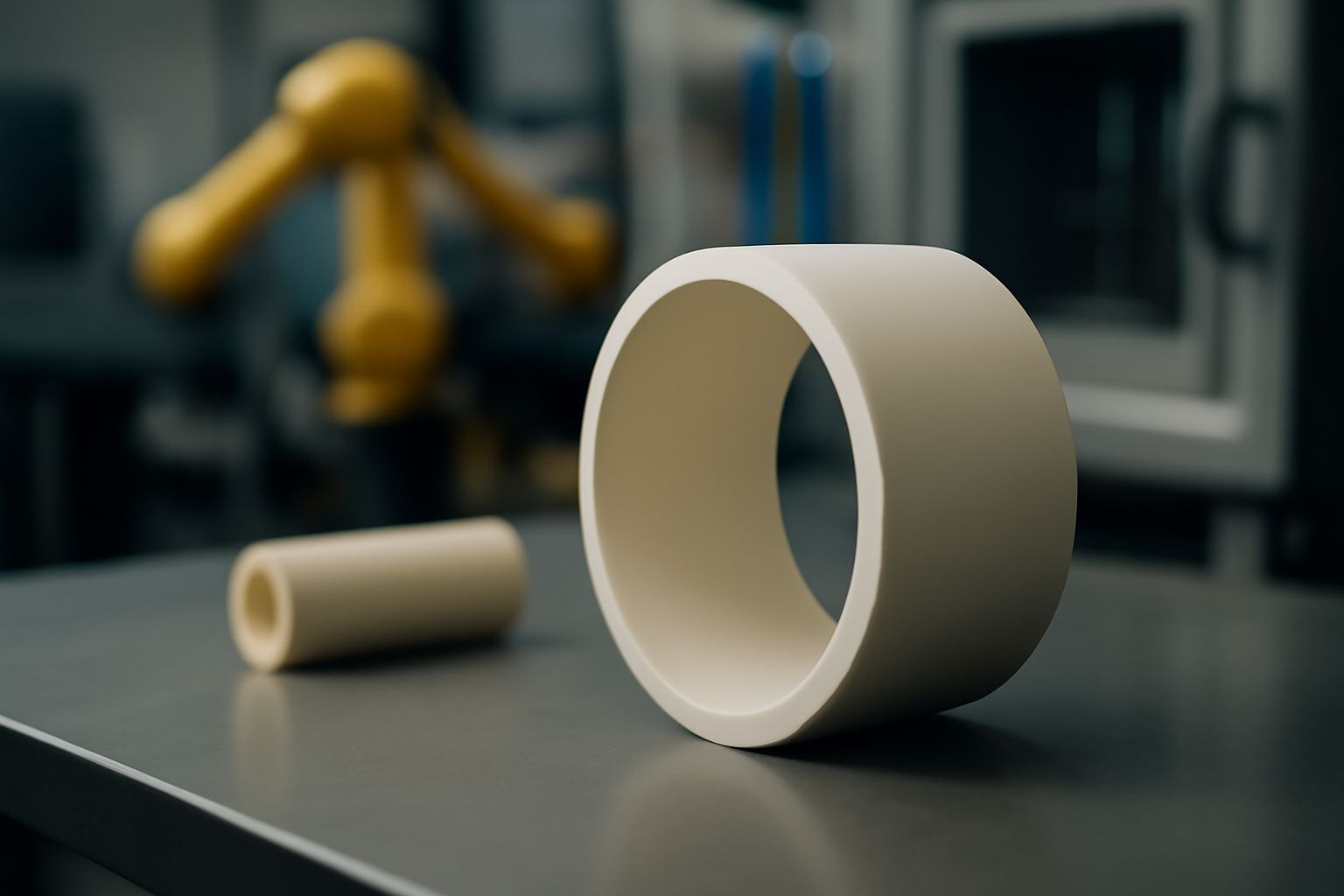Em indústrias regulamentadas, os tubos de alumina com pureza **≥99,7%** são preferidos para máxima confiabilidade, pois oferecem excelente rigidez dielétrica, baixas taxas de defeitos e tolerâncias em nível de mícron —crucial para processos críticos ou de alto estresse.

Quais graus de pureza são mais exigidos em setores regulamentados?
As principais indústrias regulamentadas exigem de forma esmagadora Tubos de cerâmica de alumina de alta pureza ≥99,7% Para garantir desempenho consistente e conformidade com as normas de segurança. Para aplicações médicas, analíticas e de engenharia de ponta, os compradores quase sempre especificam graus como 99,7%, 99,8% ou até 99,9% de alumínio. 2 O 3 devido às suas excelentes propriedades isolantes, presença mínima de contaminantes e longa vida útil. Pela minha experiência em compras, compradores na Europa, América do Norte e Japão priorizam níveis de pureza certificados ao selecionar fornecedores.
Alumina de grau inferior (90–96%) normalmente é suficiente para máquinas em geral, mas quando as regulamentações ou a estabilidade do processo são críticas, a documentação padronizada para pureza ≥99,7% torna-se essencial. Isso é especialmente verdadeiro para material de laboratório , componentes semicondutores e aplicações em tubos de isolamento de precisão. Demonstrar a capacidade de fornecer consistentemente esses graus — respaldada por relatórios de inspeção — aumenta a confiança dos líderes de compras e torna os fornecedores altamente competitivos em projetos de sourcing global.
| Grau de pureza (% Al 2 O 3 ) | Aplicação típica | Região de demanda de mercado |
|---|---|---|
| 96% | Engenharia geral, tubulação mecânica | Ásia-Pacífico, Europa Oriental |
| 99,5% | Isolamento industrial, suportes para fornos | Global (demanda média) |
| 99,7%–99,9% | Material de laboratório médico/analítico, semicondutor, de alta qualidade | América do Norte, Europa, Japão |
Como tolerâncias rigorosas melhoram o desempenho térmico e elétrico?
Tolerâncias estreitas - até ± 0,02 mm - traduzem-se diretamente em estabilidade térmica e elétrica superior em tubos de alumina de alta pureza Tubos dimensionalmente consistentes minimizam as lacunas na interface, garantindo um fluxo de calor uniforme e um isolamento elétrico consistente em todos os conjuntos de dispositivos. Na minha experiência com exportação, clientes europeus e americanos frequentemente observam aumentos nas taxas de rendimento e reduções no retrabalho de montagem ao usar tubos cerâmicos com tolerâncias de nível micrométrico.
Especialmente para aplicações de isolamento ou instalações de manuseio de gás, tolerâncias rigorosas previnem vazamentos e avarias. Quando combinados com extrusão avançada e retificação de precisão, esses tubos mantêm de forma confiável propriedades como rigidez dielétrica (>12 kV/mm) e baixa expansão térmica. Os principais OEMs em equipamentos de automação e energia consideram a tolerância rigorosa um recurso inegociável para componentes críticos.
| Nível de tolerância | Beneficiar | Uso típico |
|---|---|---|
| ±0,10 mm | Ajuste padrão, prevenção moderada de vazamentos | Isolamento geral, tubos de suporte |
| ±0,05 mm | Precisão aprimorada, contato uniforme | Isolamento de dispositivos eletrônicos, materiais de laboratório |
| ±0,02 mm | Ajuste em nível de mícron , controle térmico/elétrico ideal | Semicondutores, equipamentos analíticos |
Por que compradores globais preferem tubos de alumina testados pela ISO da China?
Os líderes globais de compras confiam cada vez mais Tubos de alumina chineses testados pela ISO por sua comprovada rastreabilidade, qualidade estável e transparência na cadeia de suprimentos. Em meus projetos recentes, compradores importantes nos EUA e na Europa solicitam especificamente a certificação ISO 9001:2015 ou padrões locais ainda mais elevados. Fabricantes chineses como a CSCERAMIC documentam a pureza, a tolerância e o desempenho mecânico/isolante de cada lote, normalmente fornecendo certificados mediante solicitação.
Em comparação com as médias do mercado, os principais exportadores da China agora oferecem agilidade, controles rigorosos de processo e vantagens de preço, em linha com as expectativas do Controle de Qualidade Ocidental. Isso é demonstrado pelos dados recentes de desempenho dos fornecedores publicados pela Inteligência de Mercado Global S&P e outros, apresentando prazos de entrega estáveis e rastreabilidade de qualidade. Auditorias ISO confiáveis, aliadas a relatórios de teste abrangentes, tornam esses tubos altamente competitivos em avaliações técnicas.
| Certificação | Garantia de Chave | Preferência do comprador |
|---|---|---|
| ISO 9001:2015 | Estabilidade do processo, rastreabilidade total | EUA, Alemanha, Japão |
| Relatório de teste IEC/ASTM | Desempenho elétrico e térmico verificado | UE, América do Norte, Coreia |
| Certificado de inspeção de material | Pureza/precisão específica do lote | OEMs técnicos, distribuidores |
Como os tubos de cerâmica funcionam em ambientes químicos agressivos?
Tubos cerâmicos de alumina de alta pureza exibem excelente resistência química , superando a maioria das alternativas metálicas em ácidos fortes, álcalis e atmosferas oxidantes. O uso recente em campo em plantas químicas europeias e laboratórios analíticos nos EUA confirma extensões de vida útil de 3 a 5 vezes em comparação com quartzo ou vidro comuns, especialmente em ambientes de fluxo contínuo ou gases ácidos de alta temperatura.
Com lixiviação iônica insignificante e sem corrosão abaixo de 99% H 2 ENTÃO 4 (até 95°C) ou soluções de NaOH, esses tubos protegem a integridade do processo e reduzem os custos de paradas. Dados verificados de Revista de Materiais MDPI (2023) demonstra que a alumina de microprecisão resiste a ciclos repetidos em meios severos muito melhor do que polímeros preenchidos ou aço. Essa confiabilidade a torna a primeira escolha para revestimentos de fornos, amostragem química e tubos de isolamento de processos semicondutores.
| Ambiente | Desempenho típico | Referência (Fonte) |
|---|---|---|
| Ácido | Sem corrosão em H 2 ENTÃO 4 , <1 mg/cm 2 perda após 24 horas de ciclismo | MDPI, 2023 |
| Alcalino | Estável sob NaOH até 80°C, alteração mínima de peso | Wikipédia |
| Oxidante/redutor | Não afetado até 1600°C, inerte na maioria das atmosferas de fornos | MDPI, 2023 |
Tubos de alumina de alta pureza oferecem consistência e estabilidade química incomparáveis para indústrias críticas em todo o mundo. Certificar a qualidade, a tolerância e a pureza gera confiança nos fornecedores em todas as aplicações regulamentadas.
Módulo CTAProcurando por tubos de alumina certificados de alta pureza ou soluções cerâmicas personalizadas?
Entre em contato com a CS CERAMIC para suporte técnico direto e entrega global rápida.




 info@csceramic.com
info@csceramic.com







 +86 18273288522
+86 18273288522